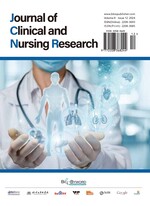Nursing Care of a Child with Panhypopituitarism After Craniopharyngioma
Abstract
This article summarizes a case of nursing management for a child diagnosed with craniopharyngioma. The targeted nursing interventions addressed panhypopituitarism, secondary hypothyroidism, secondary adrenal insufficiency, and central diabetes insipidus, which occurred as complications of the condition. The nursing priorities included the management of hypothyroidism, adrenal insufficiency, central diabetes insipidus, abnormal liver function, insulin resistance, and other related issues. The interventions resulted in stable hormone levels, maintenance of normal water and electrolyte balance, improved self-image perception, enhanced understanding of the disease and treatment plan by the child and their family, increased treatment compliance, and favorable therapeutic outcomes.
References
Tian L, Zhong L, 2019, Analysis of Risk Factors for Recurrence of Craniopharyngioma. Journal of Chongqing Medical University, 48(9): 1078–1083.
National Health Commission of the People’s Republic of China, 2021, Standard for Diagnosis and Treatment of Craniopharyngioma in Children (2021 Edition). Clinical and Education in General Practice, 19(8): 676–679.
Otte A, Müller HL, 2021, Childhood-onset Craniopharyngioma. J Clin Endocrinol Metab, 106(10): e3820–e3836. https://doi.org/10.1210/clinem/dgab397
Wang X, 2023, Effect of Hormone Replacement Therapy on Metabolic Disorders in Patients with Total Hypopituitarism After Craniopharyngioma Surgery, dissertation, Hebei Medical University.
Xia Y, Cao W, 2019, Effects of Glucocorticoid Replacement Dose on Hormone Exposure in Patients with Adenohypopituitarism. Journal of Practical Medicine & Clinic, 26(5): 406–412.
Lu X, Hang W, Liu H, et al., 2019, Experience in Diagnosis and Treatment of Postoperative Complications of Craniopharyngioma by Extended Endoscopic Transnasal Sphenoidal Approach. Journal of Clinical Otolaryngology Head and Neck Surgery, 35(6): 505–510.
Zhao T, 2024, Panhypopituitarism Complicated with Houssay Syndrome: A Case Report. J Med, 2024(10): 72–74.
Mao J, 2011, Triprorelin (LHRHα) Excitability Test. Compilation of Papers of the 10th National Endocrinology Conference of Chinese Medical Association, 2011: 2.
Fan J, Sun K, Wang J, et al., 2023, Analysis of Correlative Factors of Obesity and Some Indexes in a Population in Shihezi City. Journal of Reclamation Medicine, 45(3): 258–263.
Ji C, Zong J, Liu T, 2023, Investigation on Nutrition and Growth of Children Aged 7–12 Years in Shihezi Area. Reclamation Medicine, 45(4): 341–346.
Herrgårdh T, Simonsson C, Ekstedt M, et al., 2023, A Multi-Scale Digital Twin for Adiposity-Driven Insulin Resistance in Humans: Diet and Drug Effects. Diabetol Metab Syndr, 15(1): 250. https://doi.org/10.1186/s13098-023-01223-6
Peng X, Ge M, Wu D, et al., 2019, Risk Factors for Hypothalamic Obesity After Single-Center Craniopharyngioma Surgery in Children. Chin J Modern Neurological Diseases, 23(5): 418–424.
Gu Y, 2022, Insufficient Sleep also Leads to Obesity. Health for All, 2022(8): 40.
Shi H, 2008, Discussion on Growth Hormone Deficiency and Supplementary Therapy in Middle and Old Age. Chinese Journal of Clinical Health Care, 2008(4): 396–398.
An N, Cui Z, Huang Y, et al., 2021, The Relationship Between Serum PTH and Glucolipid Metabolism and Islet Beta Cell Function in Patients with Type 2 Diabetes Mellitus. Agricultural Reclamation Medicine, 43(1): 1–5.


